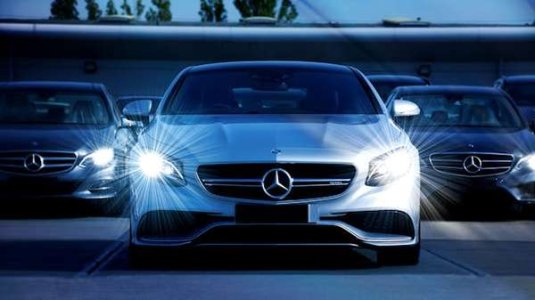Are Aussie vehicles slowly blinding you? Motorists rev up debate over this modern feature
By
Danielle F.
- Replies 1
If you've found yourself squinting, shielding your eyes, or muttering under your breath about 'those blasted headlights' when driving, you're not alone.
Across Australia, a heated debate has been raging about the latest vehicle safety tech in the country.
Is this feature actually making our roads more dangerous?
A recent News Corp Australia poll shone a spotlight on just how widespread this issue is.
Nearly 80 per cent of more than 10,000 Aussies surveyed shared that headlights in new vehicles are too bright.
Many drivers claimed that these dazzling beams have been creating hazardous conditions on the road.

This came after a study in the United Kingdom, which found that three out of four drivers felt 'blinded' by modern headlights.
This glare has contributed to over 200 collisions in 2023.
So, what's changed in today's vehicles?
The culprit behind these blinding lights was the shift from halogen bulbs to LED and High-Intensity Discharge (HID) lights.
While halogen bulbs emit between 700 and 1,200 lumens, the new kids on the block could blast 6,000 to 8,000 lumens!
The poll also managed to gather stories from frustrated drivers.
'I drive with an envelope on my dash...at night, I will put it up over my eyes to stop the glare,' said driver Ann le.
'This has been a problem since LEDs came out. I've been nearly blinded several times,' another driver, Ditchie, shared.
'If 700 lumens are enough for night driving, why are we building cars with 6,000 lumens?'
'Recently, a two-minute drive to the local servo at 10 pm, I passed three cars that seemed to have high beams on,' a third frustrated driver said.
'I seriously could not see properly for a while after they had passed.'
The UK government already launched an independent investigation into the issue.
Meanwhile, many Aussies are calling for our own inquiry.
The National Roads and Motorists' Association (NRMA), however, stated that there's little evidence that brighter headlights have led to more accidents here.
The move to LEDs and HIDs goes beyond showing off on the road.
These lights are more energy-efficient, longer-lasting, and could improve visibility for the driver in theory.
However, these lights have intense beams that could blind oncoming traffic, especially when fitted to taller vehicles like SUVs and four-wheel drives.
The higher the headlights, the more likely they are to shine directly into the eyes of drivers in smaller vehicles.
Aftermarket modifications have also become more common, with some drivers installing non-compliant bulbs that don't meet Australian Design Rules (ADR) standards.
According to the ADR, headlights must comply with their standards.
Non-compliant lights could result in penalties, defect notices, and even vehicles taken off the road.
For those considering upgrading their headlights, make sure you choose products that follow ADR compliance.
It's not just about avoiding a fine; it's about keeping everyone on the road safe.
Vehicle expert Iain Curry suggested that drivers should wait for the UK's investigation before launching a separate one in Australia.
While we wait for the government to act, here are a few tips to help you cope with the glare:

We want to hear from you, members! Have you been dazzled by modern headlights? Should Australia crack down on blinding beams, or is it just a sign of progress? Share your stories, tips, and opinions in the comments below!
Across Australia, a heated debate has been raging about the latest vehicle safety tech in the country.
Is this feature actually making our roads more dangerous?
A recent News Corp Australia poll shone a spotlight on just how widespread this issue is.
Nearly 80 per cent of more than 10,000 Aussies surveyed shared that headlights in new vehicles are too bright.
Many drivers claimed that these dazzling beams have been creating hazardous conditions on the road.

Drivers have complained over the excessively bright headlights in modern vehicles. Image Credit: Pexels/Mike Bird
This came after a study in the United Kingdom, which found that three out of four drivers felt 'blinded' by modern headlights.
This glare has contributed to over 200 collisions in 2023.
So, what's changed in today's vehicles?
The culprit behind these blinding lights was the shift from halogen bulbs to LED and High-Intensity Discharge (HID) lights.
While halogen bulbs emit between 700 and 1,200 lumens, the new kids on the block could blast 6,000 to 8,000 lumens!
The poll also managed to gather stories from frustrated drivers.
'I drive with an envelope on my dash...at night, I will put it up over my eyes to stop the glare,' said driver Ann le.
'This has been a problem since LEDs came out. I've been nearly blinded several times,' another driver, Ditchie, shared.
'If 700 lumens are enough for night driving, why are we building cars with 6,000 lumens?'
'Recently, a two-minute drive to the local servo at 10 pm, I passed three cars that seemed to have high beams on,' a third frustrated driver said.
'I seriously could not see properly for a while after they had passed.'
The UK government already launched an independent investigation into the issue.
Meanwhile, many Aussies are calling for our own inquiry.
The National Roads and Motorists' Association (NRMA), however, stated that there's little evidence that brighter headlights have led to more accidents here.
The move to LEDs and HIDs goes beyond showing off on the road.
These lights are more energy-efficient, longer-lasting, and could improve visibility for the driver in theory.
However, these lights have intense beams that could blind oncoming traffic, especially when fitted to taller vehicles like SUVs and four-wheel drives.
The higher the headlights, the more likely they are to shine directly into the eyes of drivers in smaller vehicles.
Aftermarket modifications have also become more common, with some drivers installing non-compliant bulbs that don't meet Australian Design Rules (ADR) standards.
According to the ADR, headlights must comply with their standards.
Non-compliant lights could result in penalties, defect notices, and even vehicles taken off the road.
For those considering upgrading their headlights, make sure you choose products that follow ADR compliance.
It's not just about avoiding a fine; it's about keeping everyone on the road safe.
Vehicle expert Iain Curry suggested that drivers should wait for the UK's investigation before launching a separate one in Australia.
While we wait for the government to act, here are a few tips to help you cope with the glare:
- Keep your windscreen clean (inside and out) to reduce light scatter.
- Adjust your rearview mirror to the 'night' setting to dim the headlights behind you.
- Look to the left edge of the road when oncoming vehicles approach rather than staring directly at their lights.
- If you suspect your headlights are too bright or misaligned, have them checked by a professional.
Key Takeaways
- Nearly 80 per cent of Australians believed that new vehicle headlights are too bright, with many reporting dangerous glare on the roads.
- The problem has been linked to increased use of brighter LED and HID headlights, especially on taller vehicles like SUVs and four-wheeled drives.
- Road users voiced their frustrations online and shared stories of near-misses. Experts warned that fitting non-compliant, aftermarket headlights could make vehicles unroadworthy and should lead to fines.
- While the NRMA stated that there's little direct evidence of increased accidents, there are calls for an Australian investigation into the issue.







